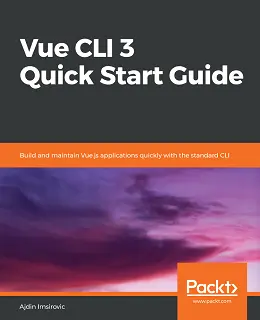Vue CLI 3 Quick Start Guide

eBook Details:
- Paperback: 200 pages
- Publisher: WOW! eBook (May 2, 2019)
- Language: English
- ISBN-10: 1789950341
- ISBN-13: 978-1789950342
eBook Description:
Vue CLI 3 Quick Start Guide: Build Vue apps the right way using Vue CLI 3. Understand how the building blocks of Vue CLI 3 work including npm, webpack, babel, eslint, plugins, GUI, testing, and SCSS. Import third-party libraries and maintain your project.
The sprawling landscape of various tools in JavaScript web development is becoming overwhelming. This book will show you how Vue CLI 3 can help you take back control of the tool chain. To that end, we’ll begin by configuring webpack, utilizing HMR, and using single-file .vue components. We’ll also use SCSS, ECMAScript, and TypeScript. We’ll unit test with Jest and perform E2E testing with Cypress.
This Vue CLI 3 Quick Start Guide book will show you how to configure Vue CLI as your default way of building Vue projects. You’ll discover the reasons behind using webpack, babel, eslint, and other modern JavaScript toolchain technologies. You’ll learn about the inner workings of each through the lens of Vue CLI 3. We’ll explore the extendibility of Vue CLI with the built-in settings, and various core and third-party plugins.
Vue CLI helps you work with Vue components, routers, directives, and services in the Vue ecosystem. While learning these concepts, you’ll examine the evolution of JavaScript. You’ll learn about use of npm, IIFEs, modules in JavaScript, Common.js modules, task runners, npm scripts, module bundlers, and webpack. You’ll get familiar with the reasons why Vue CLI 3 is set up the way it is. You’ll also learn to perform linting with ESLint and Prettier.
- Work with nvm, install Node.js and npm, use Vue CLI 3 with no configuration, via the command line and the graphical user interface
- Build a Vue project from scratch using npm and webpack, and learn about hot module replacement
- Work with Babel settings, configurations, and presets
- Work with Vue plugins, including testing plugins such as Jest and Cypress
- Write, run, and watch unit and E2E tests using TDD assertions in the red-green-refactor cycle
- Work with Vue router and use, nested, lazy-loading, and dynamic routes
- Add SCSS to your projects and work with third-party Vue plugins
- Deploy your Vue apps to Github Pages
Towards the end, we’ll introduce you to working with styles and SCSS. Finally, we’ll show you how to deploy your very own Vue project on Github Pages.